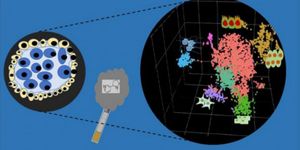Mobile Bedside Bioprinter Can Heal Wounds
Chronic, large or non-healing wounds such as diabetic pressure ulcers—have become a debilitating condition affecting millions of Americans. Now, in a study published in Nature's Scientific Reports journal, scientists at Wake Forest Institute for Regenerative Medicine (WFIRM) have developed a mobile skin bio-printing system allowing bi-layered skin to be printed directly into a wound.
A mobile skin bioprinter operated on a demo limb by a Wake Forest Institute for Regenerative Medicine technician.
Credit: WFIRM, Wake Forest Institute for Regenerative Medicine (WFIRM)
"The unique aspect of this technology is the mobility of the system and the ability to provide on-site management of extensive wounds by scanning and measuring them in order to deposit the cells directly where they are needed to create skin," says Sean Murphy, Ph.D., a WFIRM assistant professor and lead author of the study.
Scientists provided proof-of-concept of the creation by printing skin directly onto pre-clinical models. Originally, the cells are added in a hydrogel mixture before being added into the bio-printer where integrated imaging technology will transfer ‘data’ from scanning the wound into the software-- accelerating the formation of functional skin structure.
"The technology has the potential to eliminate the need for painful skin grafts that cause further disfigurement for patients suffering from large wounds or burns," said WFIRM Director Anthony Atala, M.D., and a co-author of the paper. "A mobile bioprinter that can provide on-site management of extensive wounds could help to accelerate the delivery of care and decrease costs for patients."
The next step is to conduct a clinical trial in humans. Current treatments for skin wounds involve grafts, however, adequate coverage is a challenge when the availability of healthy skin is limited as well as the risk of immune rejection. However, with the WFIRM bioprinter system many of these challenges have been addressed.
Watch this B-roll video of the mobile bio-skin printer developed by the Wake Forest Institute for Regenerative Medicine:
"If you deliver the patient's own cells, they do actively contribute to wound healing by organizing up front to start the healing process much faster," said James Yoo, M.D., Ph. D, who led the research team and co-authored the paper. "While there are other types of wound healing products available to treat wounds and help them close, those products don't actually contribute directly to the creation of skin."
Source: Wake Forest Institute for Regenerative Medicine (WFIRM)









